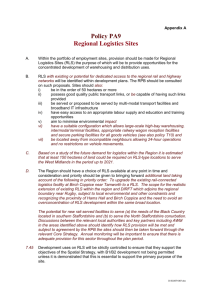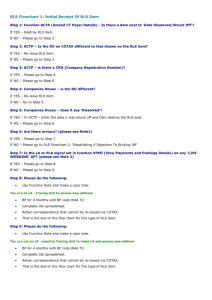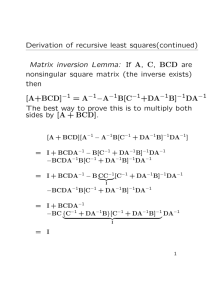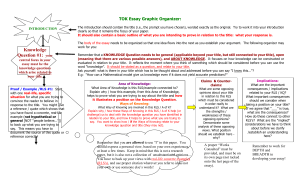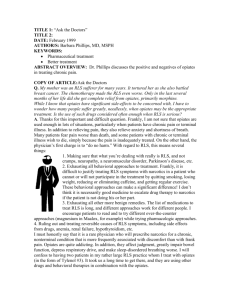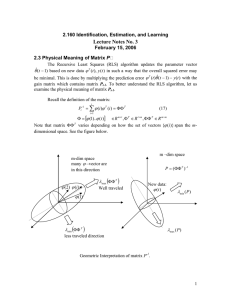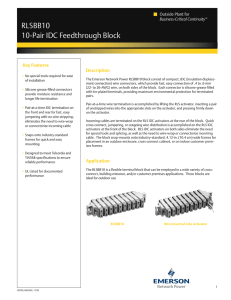Ch.10 slides
advertisement
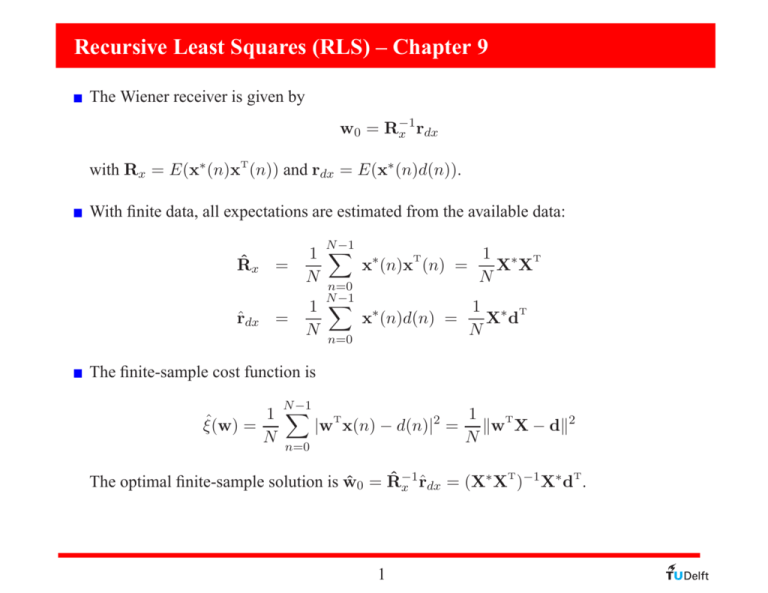
Recursive Least Squares (RLS) – Chapter 9 The Wiener receiver is given by w0 = R−1 x rdx with Rx = E(x∗ (n)xT (n)) and rdx = E(x∗ (n)d(n)). With finite data, all expectations are estimated from the available data: R̂x = r̂dx = N −1 1 X ∗ 1 ∗ T T x (n)x (n) = X X N N n=0 N −1 1 X ∗ 1 ∗ T x (n)d(n) = X d N N n=0 The finite-sample cost function is N −1 X 1 1 T T ˆ |w x(n) − d(n)|2 = kw X − dk2 ξ(w) = N N n=0 ∗ T −1 ∗ T The optimal finite-sample solution is ŵ0 = R̂−1 x r̂dx = (X X ) X d . 1 Matrix inversion lemma H H H ( A − B C−1 B )−1 = A−1 + A−1 B (C − BA−1 B )−1 BA−1 . P ROOF A B H B C = I B C−1 0 H 0 BA−1 I 0 −C−1 B I = A B H B C A B H B C −1 −1 = = = I I I I −A−1 B 0 I H H A − B C−1 B C A C − BA−1 BH H ( A − B C−1 B )−1 0 C−1 B I A−1 BH I I 0 I 0 0 C−1 A−1 (C − BA−1 BH )−1 A−1 + A−1 BH (C − BA−1 BH )−1 BA−1 ∗ ∗ 2 ∗ H I −B C−1 0 I I 0 −BA−1 I The RLS algorithm Xn := [x(0), · · · , x(n)] , Suppose at time n we know dn := [d(0), · · · , d(n)] The solution to min k wT Xn − dn k2 is ŵ(n) = (X∗n Xn )−1 X∗n dn T T =: Φ−1 n θn where T Φn := X∗n Xn = n X T T x∗ (i)x (i) , θ n := X∗n dn = i=0 n X x∗ (i)d(i) i=0 Update of Φ−1 n : Φ−1 n+1 ∗ T = (Φn + x (n + 1)x (n + 1)) −1 = Φ−1 n T ∗ −1 Φ−1 n x (n + 1)x (n + 1)Φn − ∗ 1 + xT (n + 1)Φ−1 n x (n + 1) Recursive Least Squares (RLS) algorithm: Pn x∗ (n + 1)xT (n + 1)Pn − 1 + xT (n + 1)Pn x∗ (n + 1) Pn+1 := Pn θ n+1 := θ n + x∗ (n + 1)d(n + 1) ŵ(n+1) := Pn+1 θ n+1 Initialization: θ 0 = 0 and P0 = δ −1 I, where δ is a very small positive constant. 3 The RLS algorithm Finite horizon For adaptive purposes, we want an effective window of data. 1. Sliding window: Φn and θ n based on only the last L samples: T T Φn+1 = Φn + x∗ (n + 1)x (n + 1) − x∗ (n − L)x (n − L) θ n+1 = θ n + x∗ (n + 1)d(n + 1) − x∗ (n − L)d(n − L) Doubles complexity, and we have to keep L previous data samples in memory. 2. Exponential window: scale down Φn and θ n by a factor λ ≈ 1: T Φn+1 = λΦn + x∗ (n + 1)x (n + 1) θ n+1 = λθ n + x∗ (n + 1)d(n + 1) Corresponds to Xn+1 = [x(n + 1) λ1/2 x(n) λx(n − 1) λ3/2 x(n − 2) · · · ] dk+1 = [d(n + 1) λ1/2 d(n) λd(n − 1) 4 λ3/2 d(n − 2) · · · ] The RLS algorithm Exponentially weighted RLS algorithm: − Pn x∗ (n + 1)xT (n + 1)Pn 1 + λ−1 xT (n + 1)Pn x∗ (n + 1) Pn+1 := θ n+1 := λθ n + x∗ (n + 1)d(n + 1) λ−1 Pn λ−2 ŵ(n+1) := Pn+1 θ n+1 convergence of output error cost function 0.6 RLS LMS SGD 0.5 J 0.4 0.3 µ=0.088 0.2 λ=0.7 0.1 λ=1 0 0 50 100 time [samples] 5 150

